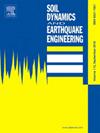Seismic demand-oriented design of hybrid base-isolated building with the tuned inerter eddy current damper
IF 4.2
2区 工程技术
Q1 ENGINEERING, GEOLOGICAL
引用次数: 0
Abstract
A novel tuned inerter eddy current damper (TIECD) is proposed to mitigate isolator deformation in a base isolation (BI) system subjected to earthquake ground motions. Considering the topological similarity and damping equivalent criteria, the design formulations of the tuned inerter damper are extended to determine the optimal parameters of the TIECD. A combination of iterative updating, response-spectrum analysis, and complex complete quadratic-combination measures is established to realize the seismic demand-oriented design framework of the TIECD. Furthermore, the proposed design framework incorporates the equivalent stiffness and damping of a lead rubber bearing to approximate the design parameters of the TIECD in a nonlinear BI system. Finally, the feasibility and effectiveness of the designed TIECD are validated using a nine–story base isolated benchmark model with lead rubber bearings. Numerical simulation results indicate that the designed TIECD can significantly suppress the displacement, acceleration, and base shear demands of the hybrid BI system. Compared with the viscous damping in the tuned inerter damper, the designed TIECD exhibits a significantly enhanced level of damping owing to the combination of a lower damping force and a larger deformation.
采用调谐感应器涡流阻尼器的混合式基础隔震建筑的地震需求导向设计
本文提出了一种新型的调谐电感涡流阻尼器 (TIECD),用于减轻受地震地面运动影响的基础隔震系统中的隔震器变形。考虑到拓扑相似性和阻尼等效标准,扩展了调谐电感阻尼器的设计公式,以确定 TIECD 的最佳参数。结合迭代更新、响应谱分析和复杂的完全二次组合措施,建立了以地震需求为导向的 TIECD 设计框架。此外,所提出的设计框架还结合了铅橡胶支座的等效刚度和阻尼,以近似非线性 BI 系统中 TIECD 的设计参数。最后,使用带铅橡胶支座的九层底座隔离基准模型验证了所设计 TIECD 的可行性和有效性。数值模拟结果表明,设计的 TIECD 可以显著抑制混合 BI 系统的位移、加速度和基底剪切力需求。与调谐插入式阻尼器中的粘滞阻尼相比,设计的 TIECD 由于结合了较低的阻尼力和较大的变形,因此阻尼水平明显提高。
本文章由计算机程序翻译,如有差异,请以英文原文为准。
求助全文
约1分钟内获得全文
求助全文
来源期刊

Soil Dynamics and Earthquake Engineering
工程技术-地球科学综合
CiteScore
7.50
自引率
15.00%
发文量
446
审稿时长
8 months
期刊介绍:
The journal aims to encourage and enhance the role of mechanics and other disciplines as they relate to earthquake engineering by providing opportunities for the publication of the work of applied mathematicians, engineers and other applied scientists involved in solving problems closely related to the field of earthquake engineering and geotechnical earthquake engineering.
Emphasis is placed on new concepts and techniques, but case histories will also be published if they enhance the presentation and understanding of new technical concepts.
 求助内容:
求助内容: 应助结果提醒方式:
应助结果提醒方式:


